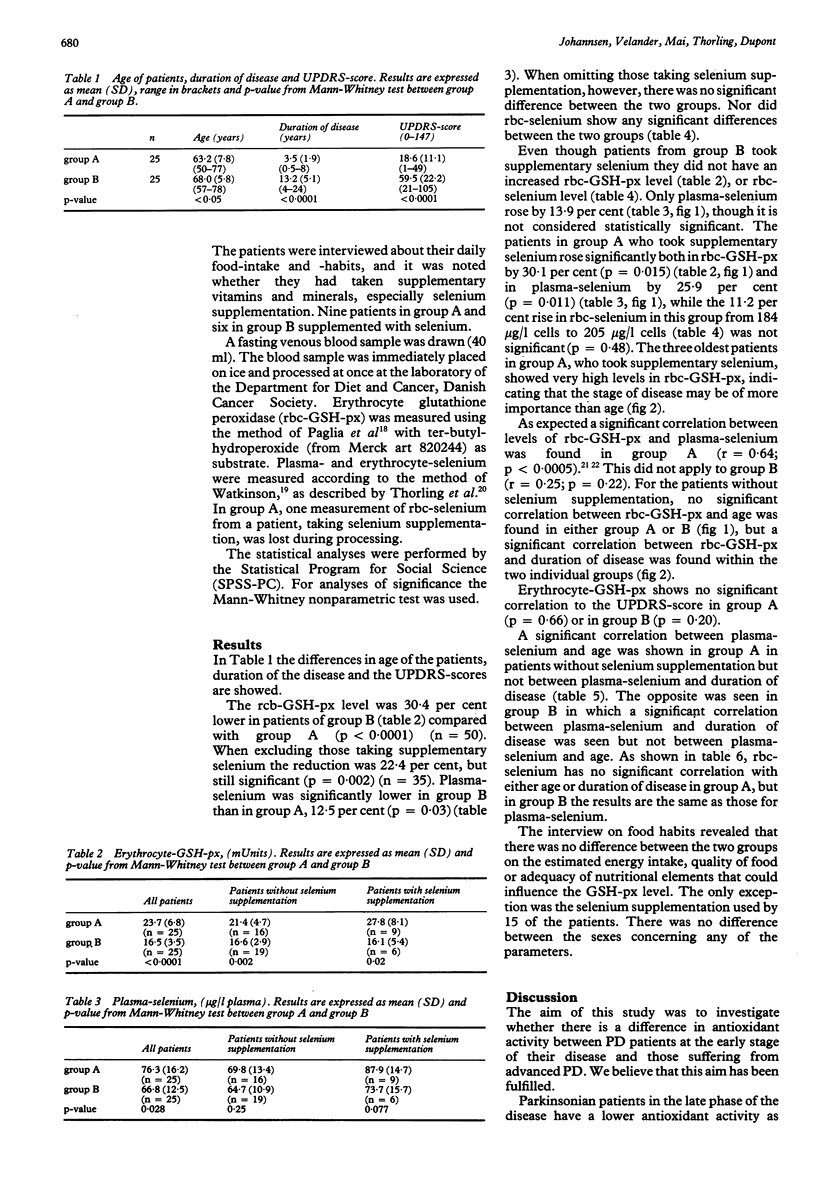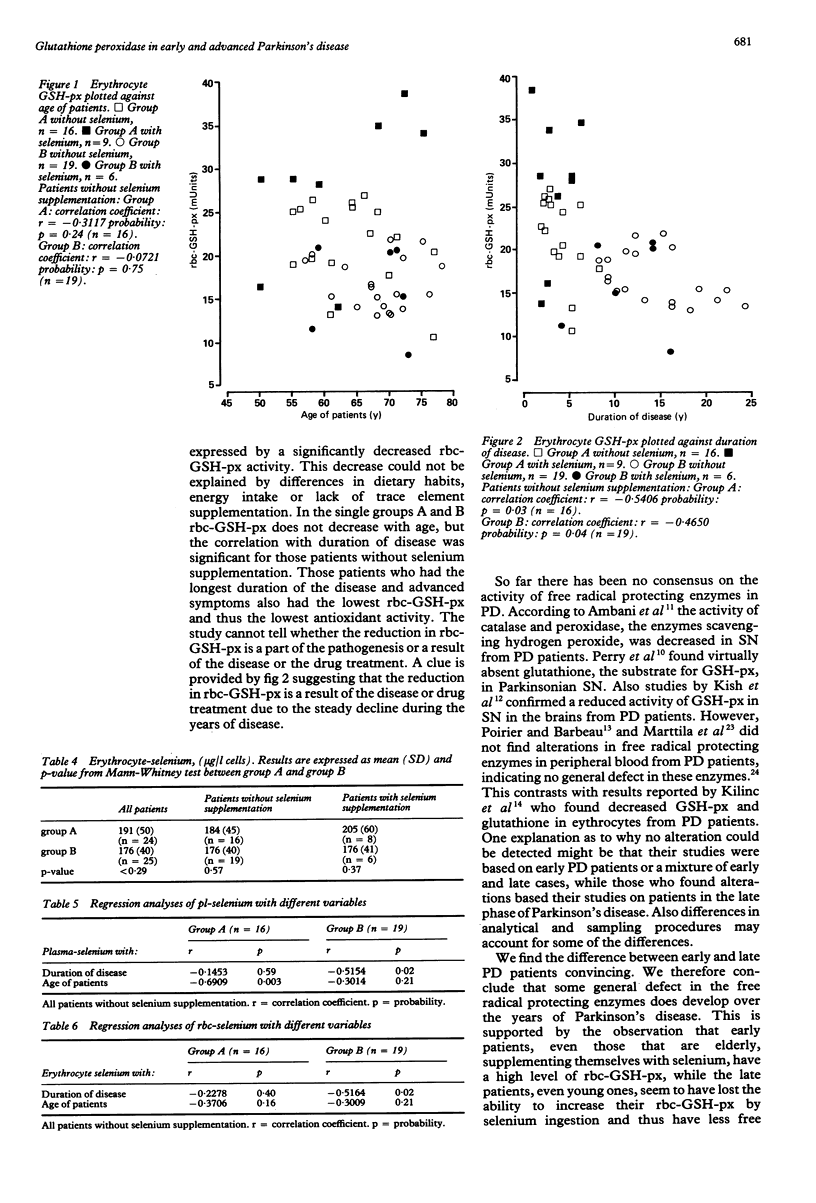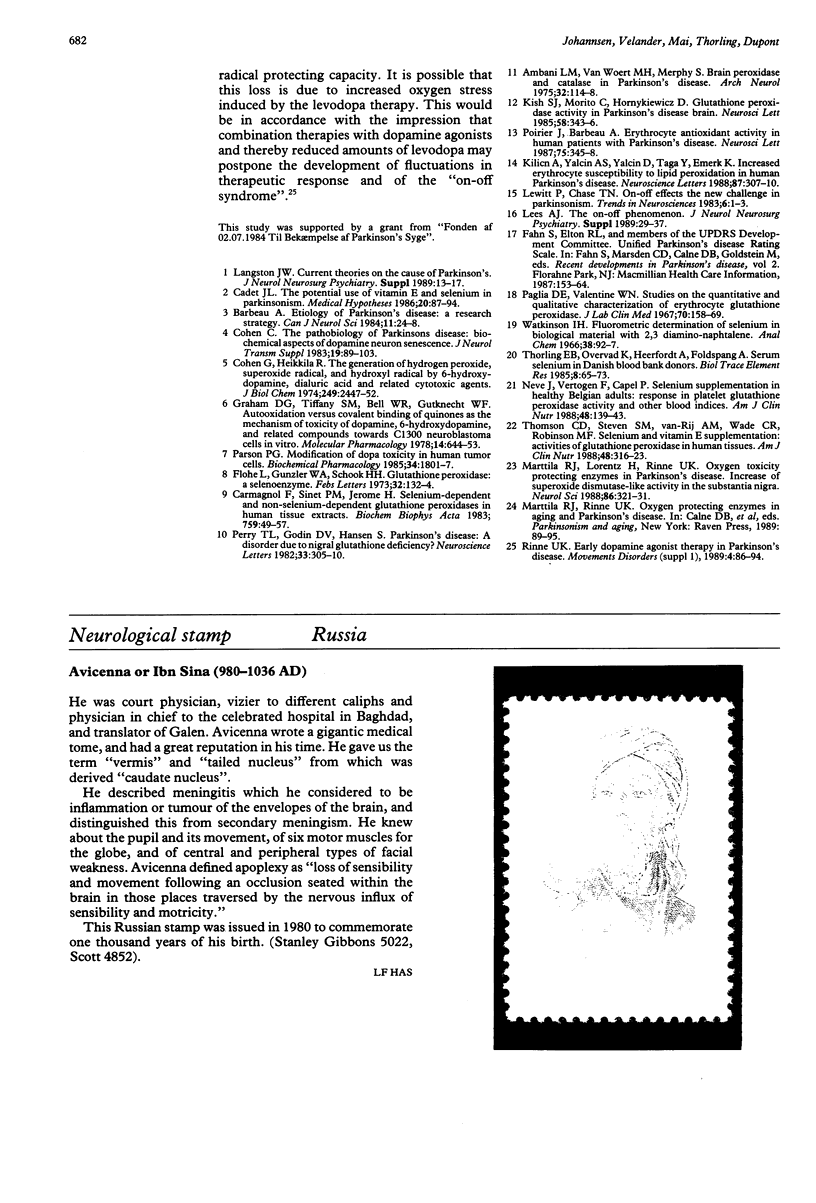Abstract
A defective antioxidant scavenging system plays a major role in one of the theories of the pathogenesis of Parkinson's disease. The aim of this study was to investigate whether there is a general difference in antioxidant activity between early and advanced cases of Parkinson's disease. Twenty five recently diagnosed patients, without any clinical fluctuations (group A), and 25 patients in a late phase of the disease with severe fluctuations in response to levodopa therapy (group B) were included in the study. Erythrocyte glutathione peroxidase was determined as a measure of antioxidant activity and significantly lower values were found in group B than in group A. Regression analyses in groups A and B showed significant correlation between glutathione peroxidase and duration of disease, but not between glutathione peroxidase and age of patients.
Full text
PDF



Images in this article
Selected References
These references are in PubMed. This may not be the complete list of references from this article.
- Barbeau A. Etiology of Parkinson's disease: A research strategy. Can J Neurol Sci. 1984 Feb;11(1):24–28. doi: 10.1017/s0317167100045273. [DOI] [PubMed] [Google Scholar]
- Cadet J. L. The potential use of vitamin E and selenium in parkinsonism. Med Hypotheses. 1986 May;20(1):87–94. doi: 10.1016/0306-9877(86)90089-7. [DOI] [PubMed] [Google Scholar]
- Carmagnol F., Sinet P. M., Jerome H. Selenium-dependent and non-selenium-dependent glutathione peroxidases in human tissue extracts. Biochim Biophys Acta. 1983 Aug 23;759(1-2):49–57. doi: 10.1016/0304-4165(83)90188-5. [DOI] [PubMed] [Google Scholar]
- Cohen G., Heikkila R. E. The generation of hydrogen peroxide, superoxide radical, and hydroxyl radical by 6-hydroxydopamine, dialuric acid, and related cytotoxic agents. J Biol Chem. 1974 Apr 25;249(8):2447–2452. [PubMed] [Google Scholar]
- Cohen G. The pathobiology of Parkinson's disease: biochemical aspects of dopamine neuron senescence. J Neural Transm Suppl. 1983;19:89–103. [PubMed] [Google Scholar]
- Flohe L., Günzler W. A., Schock H. H. Glutathione peroxidase: a selenoenzyme. FEBS Lett. 1973 May 15;32(1):132–134. doi: 10.1016/0014-5793(73)80755-0. [DOI] [PubMed] [Google Scholar]
- Graham D. G., Tiffany S. M., Bell W. R., Jr, Gutknecht W. F. Autoxidation versus covalent binding of quinones as the mechanism of toxicity of dopamine, 6-hydroxydopamine, and related compounds toward C1300 neuroblastoma cells in vitro. Mol Pharmacol. 1978 Jul;14(4):644–653. [PubMed] [Google Scholar]
- Kilinç A., Yalçin A. S., Yalçin D., Taga Y., Emerk K. Increased erythrocyte susceptibility to lipid peroxidation in human Parkinson's disease. Neurosci Lett. 1988 May 3;87(3):307–310. doi: 10.1016/0304-3940(88)90467-3. [DOI] [PubMed] [Google Scholar]
- Kish S. J., Morito C., Hornykiewicz O. Glutathione peroxidase activity in Parkinson's disease brain. Neurosci Lett. 1985 Aug 5;58(3):343–346. doi: 10.1016/0304-3940(85)90078-3. [DOI] [PubMed] [Google Scholar]
- Langston J. W. Current theories on the cause of Parkinson's disease. J Neurol Neurosurg Psychiatry. 1989 Jun;Suppl:13–17. doi: 10.1136/jnnp.52.suppl.13. [DOI] [PMC free article] [PubMed] [Google Scholar]
- Lees A. J. The on-off phenomenon. J Neurol Neurosurg Psychiatry. 1989 Jun;Suppl:29–37. doi: 10.1136/jnnp.52.suppl.29. [DOI] [PMC free article] [PubMed] [Google Scholar]
- Marttila R. J., Lorentz H., Rinne U. K. Oxygen toxicity protecting enzymes in Parkinson's disease. Increase of superoxide dismutase-like activity in the substantia nigra and basal nucleus. J Neurol Sci. 1988 Sep;86(2-3):321–331. doi: 10.1016/0022-510x(88)90108-6. [DOI] [PubMed] [Google Scholar]
- Nève J., Vertongen F., Capel P. Selenium supplementation in healthy Belgian adults: response in platelet glutathione peroxidase activity and other blood indices. Am J Clin Nutr. 1988 Jul;48(1):139–143. doi: 10.1093/ajcn/48.1.139. [DOI] [PubMed] [Google Scholar]
- Paglia D. E., Valentine W. N. Studies on the quantitative and qualitative characterization of erythrocyte glutathione peroxidase. J Lab Clin Med. 1967 Jul;70(1):158–169. [PubMed] [Google Scholar]
- Parsons P. G. Modification of dopa toxicity in human tumour cells. Biochem Pharmacol. 1985 May 15;34(10):1801–1807. doi: 10.1016/0006-2952(85)90652-5. [DOI] [PubMed] [Google Scholar]
- Perry T. L., Godin D. V., Hansen S. Parkinson's disease: a disorder due to nigral glutathione deficiency? Neurosci Lett. 1982 Dec 13;33(3):305–310. doi: 10.1016/0304-3940(82)90390-1. [DOI] [PubMed] [Google Scholar]
- Poirier J., Barbeau A. Erythrocyte antioxidant activity in human patients with Parkinson's disease. Neurosci Lett. 1987 Apr 10;75(3):345–348. doi: 10.1016/0304-3940(87)90547-7. [DOI] [PubMed] [Google Scholar]
- Thomson C. D., Steven S. M., van Rij A. M., Wade C. R., Robinson M. F. Selenium and vitamin E supplementation: activities of glutathione peroxidase in human tissues. Am J Clin Nutr. 1988 Aug;48(2):316–323. doi: 10.1093/ajcn/48.2.316. [DOI] [PubMed] [Google Scholar]
- Watkinson J. H. Fluorometric determination of selenium in biological material with 2,3-diaminonaphthalene. Anal Chem. 1966 Jan;38(1):92–97. doi: 10.1021/ac60233a025. [DOI] [PubMed] [Google Scholar]



